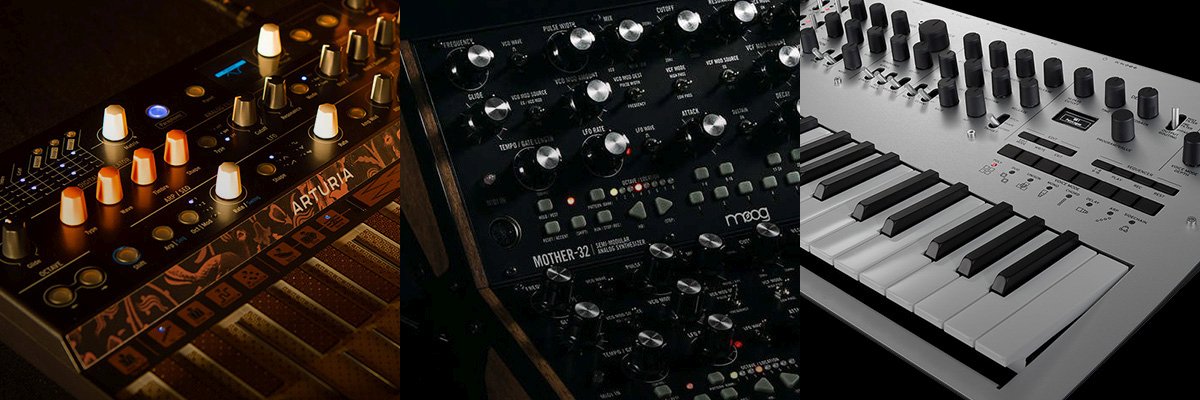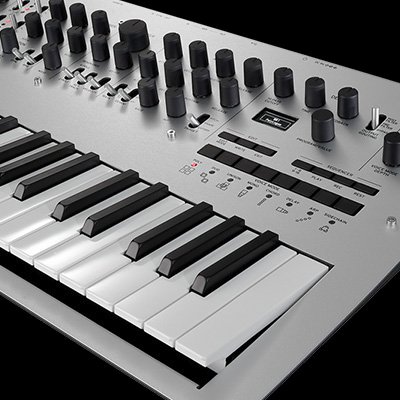Top 7 Analog Synthesizers for Beginners

Especially at the beginning, it is always a difficult choice for many, which gear and synth fits my needs and helps me advance. So today we’re going to take a look at what are probably the best analog synthesizers for beginners. Little disclaimer – all of the following are based on personal opinion and experience. Tastes and views are always different, but of course I hope that this guide will help some when choosing their next tool in the studio.
#1 BEHRINGER NEUTRON
Some specs and highlights
– analog signal path
– 2 VCOs with CEM3340 chips
– stepless cross-fading between 5 waveforms
– Paraphony mode for two-part sounds
– Multimode VCF with resonance
– analog BBD delay
– Patch panel with 32 inputs and 24 outputs
– Connection options to other modular synthesizers & sequencers
– Can be rack-mounted and installed into Eurorack cases
Retail price: 269 €
Probably not a big surprise after Behringer has literally overtaken the world of hardware synthesizers with a lot of re-productions of classics. The balance of features, sound quality and price alone makes the Neutron an indispensable part of the list.
Unlike most of the new Behringer analog synthesizers, the Neutron is not based on a classic from the past. However, it offers the best entry point for anyone who is more concerned with analog (and also modular) synthesis and wants to explore it. Due to its semi-modular concept, it can massively expand its sound spectrum even without external hardware due to the amount of patch points and at the same time remains very clear in terms of operation. As with all new Behringer analog synthesizers, the sound quality is really good and offers the option of installing the synthesizer either (through an additional kit) in the 19 rack, or directly in a eurorack case along with other eurorack modules to build a new system or it better to integrate into an existing one. A big plus in my eyes. And for a retail price of less than 300 euros, it’s also an absolute no-brainer. Something comparable to, say, “manufacturing well-known” would certainly cost twice as much and would still have a little less functionality.
More info: Behringer.com
#2 ARTURIA MINIBRUTE 2
Some specs and highlights
– Touch-sensitive and pressure-sensitive keyboard with 25 keys
– Two analog oscillators
– VCO1 with UltraSaw, Metalizer, linear and exponential FM
– Hard sync between VCO 2 & 1
– 12dB Steiner Parker multimode filter
– 48-point patchbay with inputs and outputs
– Tool modules: inverter, attenuator, VCA
– Sequencer with up to 64 steps
Retail price: 489 €
In comparison to the Behringer Neutron, the Arturia Minibrute 2, offers a more direct handling thanks to the 25-key keyboard and also a slightly different sound. Also, semi-modular, enables creative to complex interconnections, also with built-in tools such as an inverter. Due to the mixable waveforms (and with the ultrasaw & metalizer) a high variety of sounds can be created very easily, which can probably be a little less typical for analog synthesizers. This is definitely not a disadvantage, rather an advantage because it expands the sound spectrum again. Using and playing the Minibrute 2 is very pleasant, you have a clear view of all the controllers, and you can play the notes or program sequences directly on the device.
In addition, you should perhaps perceive the Minibrute 2 as a possible option to be able to play your Eurorack modular system directly. Definitely great value for money and easy to use.
More info: Arturia.com
#3 KORG MONOLOGUE
Some specs and highlights
– 4 voice polyphony
– 37 velocity-sensitive slim keys
– fully programmable (100 presets & 100 user sounds)
– Automated and polyphonic 16 step sequencer with motion sequencer
– OLED Display for the waveform generated by the oscilloscope function
– Audio sync for all studio / live requirements and connection with SQ1, Volca, Electribe and others possible
– 41 Control elements for direct access to the permanently assigned parameters
Retail price: 499 €
From the visual impression alone, it is probably the sexiest synth on this list (awarded with the Red Dot Award in Germany). The Minilogue is not semi-modular like its two predecessors, but it offers other advantages such as a 37 slim key keyboard, OLED display for the waveform. Of course, the possibilities of the sound spectrum are a little less, or rather not as open to connect to other devices as it is with eurorack compatible synths, but the Minilogue is a very solid synth with an extremely pleasant feel to use. Everything is sorted, clearly arranged, the essential parameters are directly accessible and the optics – simply pleasant.
And of course, the 4-way polyphony is a big plus. Either for more complex melodies or characterful chords. And in the lower price segment, or in general, with analog synthesizers, polyphonic is felt to be a luxury, be it as built-in features in general and/or due to the associated price.
Extra tip: There is also an extended version of the Minilogue: the “Minilogue XD”. This has an additional third digital multi-engine oscillator: Noise, VPM (Variable Phase Modulation) / FM oscillator with 2-operator structure & user wavetables). There is also more space for presets, up to 500 in total.
More info: Korg.com
PROMO: LATEST PRESET PACKS AND UPDATES
#4 MOOG MOTHER-32
Some specs and highlights
– VC controlled 32-step sequencer with 64 sequence locations
– Low Pass & High Pass Moog Ladder Filter (20 – 20000 Hz)
– Classic Moog oscillator with pulse and sawtooth wave outputs
– semi-modular layout
– MIDI input and MIDI to CV converter
– 32 modular patchbay with 5 patch cables 3.5 mm mini jack
– Main module is Eurorack compatible
Retail price: 599 €
Of course, no guide to analog synthesizers should be without a Moog synth. And the Mother-32 is definitely an ideal starter for every musician who wants to experience the warm and powerful sound that everyone raves about.
The combination of a classic moog oscillator, ladder filter and a creative step sequencer with up to 64 on-board sequences creates a well-rounded overall package. Of course, well-known quality also has its (higher) price – compared to, for example, Behringer Model-D and similar. Mother-32 can also operate the synth module either in its housing as a standalone, or without a housing in a eurorack case. Moog also offers its own case stands to run 2 or 3 Mother-32s in a team – or in combination with Moog’s DFAM or Subharmonicon.
More info: Moogmusic.com
#5 BEHRINGER 2600
Some specs and highlights
– Clone of the ARP 2600 (1970-1980)
– Monophonic or duophonic playable
– semi-modular layout
– Use as desktop or build into a studio rack
– Three analog oscillators (some with switchable synchronization)
– Filter switchable between ARP and Moog character
– Ring modulator, noise generator & voltage processor
– Mixable spring reverb effect
Retail price: 599 €
One of the most famous analog synthesizers is the ARP 2600. In the meantime, this classic from the 70s to the 80s is rarely available for sale, and when of course only used and very rarely in good condition. Fortunately, there is now a pretty good clone of this analogue legend from behringer.
For many, the details and visual information of the 2600’s user interface may be a bit overwhelming. However, after a short period of acclimatization, you will quickly get to grips with it and also recognize the practical benefits of better visualizing the signal path and all functions, which ultimately also makes operation easier. For the price you definitely get a lot of hardware synthesizers. Which, by the way, can also be conveniently installed in typical 19-inch racks.
More info: Behringer.com
#6 ROLAND SE-02
Some specs and highlights
– Cooperation between Studio Electronics and Roland
– 3 VCOs with six different waveforms
– 24 dB low-pass filter
– Three types of cross modulation, feedback loop and noise generator
– LFO with nine waveforms
– Digital delay with bypass function
– Memory for 384 presets
– Step sequencer, CV and VCF CV inputs and a gate input
– USB audio for A / D signal processing
Retail price: 469 €
When you think of classic analog synthesizers, you never get around the Minimoog. And that is the reason why the Roland SE-02 also deserves a place in this list. Some will probably ask themselves “Why not the Behringer Model-D?” There are 4 good answers to this:
1) The SE-02 was not developed by Roland alone, but in collaboration with the synth veterans of Studio Electronics. And they know exactly what makes a top analog synth.
2) Presets! That’s right, despite the complete analog signal path (except for the digital delay, of course) the SE-02 can save and load presets, which makes it very flexible for beginners and also in terms of sound design. And of course it is also an advantage in day-to-day production. Not many full analog synths offer that feature (or can’t …)
3) The 16-step sequencer with storage space for up to 128 patterns is another plus. Especially in direct comparison to the Model-D.
4) USB-Audo, you can integrate your SE-02 directly into your DAW via USB, without an audio interface. Maybe not a feature in terms of sound, but one thing that makes using the SE-02 more comfortable.
The only drawback is unfortunately the size, like all synths in the Roland Boutique series, they are small or “space-saving”, but that also means – very small knobs. Therefore, the handling is not quite as ergonomic and pleasant as with other analog synths.
More info: Roland.com
#7 ARTURIA MICROFREAK
Some specs and highlights
– Digital-analog hybrid synthesizer
– 25-key touch keyboard, velocity sensitive with polyphonic aftertouch
– 16 digital oscillator modes, including engines from Mutable Instruments and Noise Engineering
– Monophone or paraphone up to four voices
– Analog Oberheim SEM filter
– 16-band vocoder
– Modulation matrix
– Loopable contour generator & Arpeggiator
– Sequencer with 4 automation tracks and random parameters (64 steps)
– 384 preset slots and 320 factory presets
– OLED display for editing and parameter values
Retail price: 329 €
Yes, I know what most people think now … “Microfreak isn’t an analog synthesizer, is it?” and yes you are right. The Microfreak is a hybrid of digital synthesis and analog filters – but thanks to the large number of really good features and at least parts of the signal path in analog, it still deserves a place here.
Especially for users, it offers a real fund of synthesis models from well-known modular developers such as Mutable Instruments and Noise Engineering. Vocoder and analog SEM-like filter. A pleasant operation, easy to understand, coupled with the OLED display very user-friendly. A lot of factory presets, modulation matrix with which, despite the compact layout, an unbelievable amount of sounds and movement in the sound is possible. the sequencer with its automation tracks provides even more creative freedom and the icing on the cake is the 25-key capacitive keybed with polyphonic aftertouch.
Simply a super complete package for an unbeatable price. Even if, as mentioned, it is a digital-analog hybrid, instead of a completely analog synthesizer, the microfreak offers a lot of leeway and inspiration for beginners to explore thanks to the features around the sound such as the sequencer and keybed.
More info: Arturia.com
I hope this little guide about analog synthesizers for beginners and starters might give some of you new ideas, inspiration and/or at least a pleasant read. Thank you for reading!












